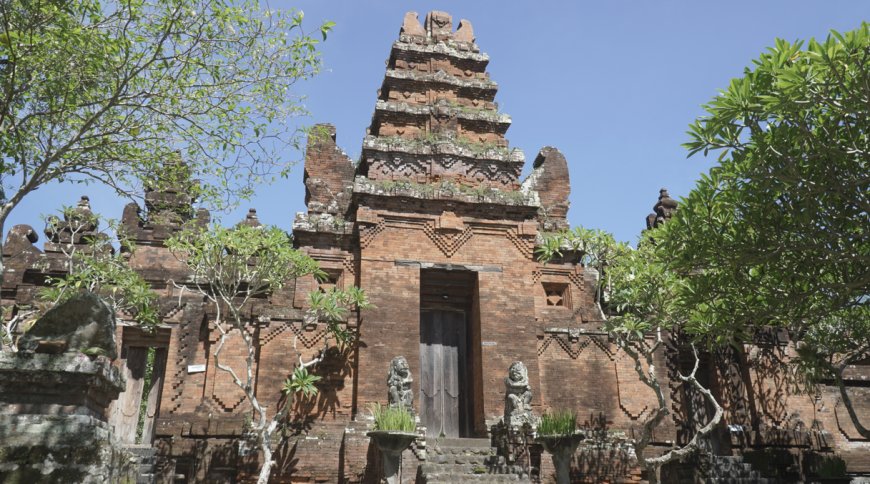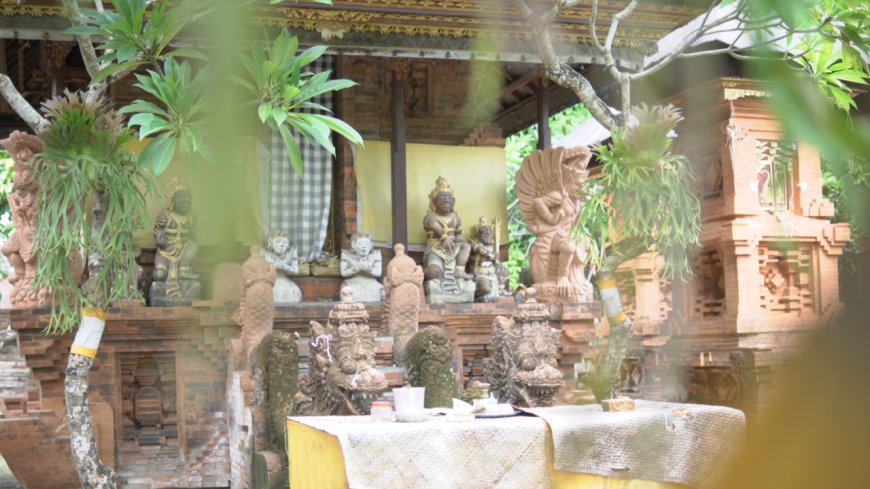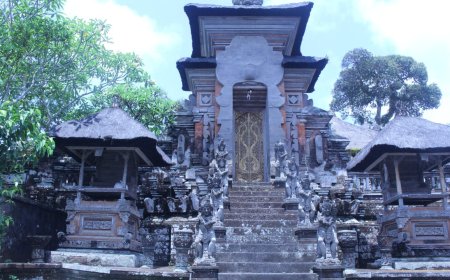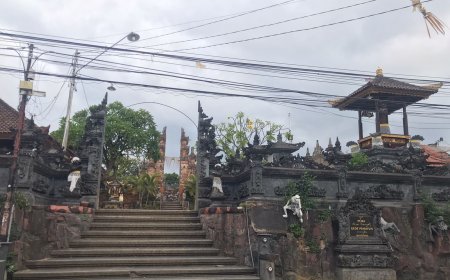Exploration of the Existence of Dalem Mutering Jagat Kesiman Temple in Bali
Dalem Mutering Jagat Temple was built by Arya Wang Bang Pinatih, an envoy from Majapahit, at the site of Ida Dalem Batu Ireng's legacy, a Balinese king who attained moksha on the banks of the Ayung River. This temple is associated with Pura Agung Petilan, renowned for the Ngerebong ceremony. It also preserves the story of Brahmana Keling, a priest who cursed Bali due to insults from the king. The temple boasts grand and expansive architecture, employing the Tri Mandala concept.

Pura Dalem Mutering Jagat is one of the temples located in Kesiman Kertalangu Village, Denpasar City, Bali. This temple has a long history and is closely related to Pura Agung Petilan or Pura Ngerebong, renowned for the Ngerebong ceremony held every 210 days. Pura Dalem Mutering Jagat was built by Arya Wang Bang Penatih, an envoy from the Majapahit Kingdom who came to Bali to continue Simakrama, a governance system that regulates the relationship between the king and the people. Arya Wang Bang Penatih established this temple at a place called Kusima, the site of the legacy of Ida Dalem Batu Ireng, a Balinese king who achieved moksha or perfection on the banks of the Ayung River.
The Ayung River indeed holds profound meaning for the Balinese people. Besides being considered a place that holds blessings and tranquility, the river is also revered as a source of life and spirituality. Batu Sima, located on the riverbank, becomes an important symbol in commemorating the yadnya moksa ceremony performed by Ida Dalem Batu Ireng and his descendants.

Ayung River (Source: Author's Collection)
In the cultural context of Bali, the yadnya moksa ceremony is a form of sacrifice performed with the aim of reaching a state of purity and perfection. This reflects the belief in the cycle of life, reincarnation, and the search for spiritual enlightenment. The Ayung River, also known as We Ayu, meaning beautiful water, creates a calm and enchanting atmosphere in its surroundings. The natural beauty also adds spiritual value for the local community. May the cultural heritage and spirituality embedded in the Ayung River continue to be preserved and respected by future generations.
Pura Dalem Mutering Jagat boasts a magnificent and expansive architecture, utilizing the concept of Tri Mandala, which divides the temple into three courtyards representing three levels of the world: nista mandala (lower world), madya mandala (middle world), and utama mandala (upper world). The main courtyard is the holiest place, housing significant structures such as padmasana, meru, bale pesandekan, and bale panggungan. Padmasana is a square-shaped structure serving as a place of worship for Ida Sang Hyang Widhi Wasa, the Supreme God in Hinduism. Meru is a tower-shaped building with tiered roofs, symbolizing the sacred mountain where the gods reside. Bale pesandekan functions as a storage place for ceremonial equipment like pedupaan, kendi, and others. Bale panggungan is a structure used for artistic performances, such as dance and wayang. The middle courtyard is designated for religious activities like prayer and offerings, where Hindu devotees express their spiritual reverence. Meanwhile, the outer courtyard is intended for social activities, providing space for gatherings and relaxation, fostering community bonds.

Dalem Mutering Jagat Kesiman Temple (Source: Author's Collection)
The temple celebrates its piodalan, a religious festival, on Wraspati wuku Sungsang, coinciding with the Sugihan Jawa festival. Sugihan Jawa is a ceremony honoring ancestors, acknowledging the cultural roots from Java that have influenced Bali for many years. The piodalan day involves various religious activities like prayer, offerings, and tirta yatra, a pilgrimage to sacred places. These activities strengthen the spiritual connection of Hindu devotees with God and their ancestors. The ceremony also serves as a manifestation of respect for the cultural heritage and beliefs passed down by the ancestors. The significance of the piodalan goes beyond the spiritual context; it also serves as a moment to celebrate and maintain the continuity of the relationship between Bali and Java. The long history and mutual influence between the two islands are reflected in the Sugihan Jawa ceremony presented at Pura Dalem Mutering Jagat.
The piodalan moment is not only a religious event but also an opportunity to weave the threads of history and camaraderie between Bali and Java. By preserving this tradition, the Balinese community not only celebrates their religious identity but also strengthens the cultural and historical ties with the neighboring island.

Dalem Mutering Jagat Kesiman Temple (Source: Author's Collection)
Pura Dalem Mutering Jagat is not only a place of worship but also a guardian of the rich history and culture of the Balinese society. The temple bears witness to the development of Balinese society over time, reflecting the religious values and traditions passed down from generation to generation. One intriguing story associated with Pura Dalem Mutering Jagat is the tale of Brahmana Keling. This story depicts the journey of a priest from East Java, Brahmana Keling, who came to Bali to assist his brother, King Dalem Waturenggong, in conducting the Eka Dasa Rudra ceremony at Besakih. Despite his noble intentions, Brahmana Keling faced humiliation due to his shabby appearance, going unrecognized by the king and being scorned by royal officials. In anger, Brahmana Keling cursed Bali to become barren and suffer. The curse only ceased after the king apologized and bestowed the title of Dalem Sidakarya upon Brahmana Keling. This title means "the one who resolves issues," symbolizing a change in attitude and the respect granted to Brahmana Keling.
This story is the origin of the name Pura Mutering Jagat Dalem Sidakarya, closely linked to Pura Dalem Mutering Jagat. As part of Bali's cultural heritage, this tale provides profound insight into the importance of respect, apologies, and peace in the lives of the Balinese community.
Pura Dalem Mutering Jagat is indeed a tourist destination worth visiting for both local residents and tourists alike. The uniqueness of this temple is not only evident in its magnificent architecture but also in the serene atmosphere that can be felt around the flowing river beside it. Additionally, Pura Dalem Mutering Jagat provides valuable lessons about the history and culture of Bali.
Admiring the architectural beauty of the temple will lead visitors to a profound experience, fostering admiration for the traditional Balinese construction skills. The presence of the river surrounding the temple adds a soothing natural touch, creating an environment conducive to spiritual reflection and tranquility. Furthermore, Pura Dalem Mutering Jagat offers various artistic and cultural attractions, such as wayang dance performances. Traditional Balinese arts not only entertain but also provide insights into the cultural values firmly held by the Balinese community.
As a cultural heritage, it is a collective responsibility to preserve and protect Pura Dalem Mutering Jagat. Visitors, whether local or from outside Bali, are encouraged to respect the spiritual values and local wisdom embedded within the temple. In doing so, Pura Dalem Mutering Jagat can continue to be a sacred and precious place for the Balinese people, serving as a captivating tourist attraction that enriches the experiences of travelers.






























































